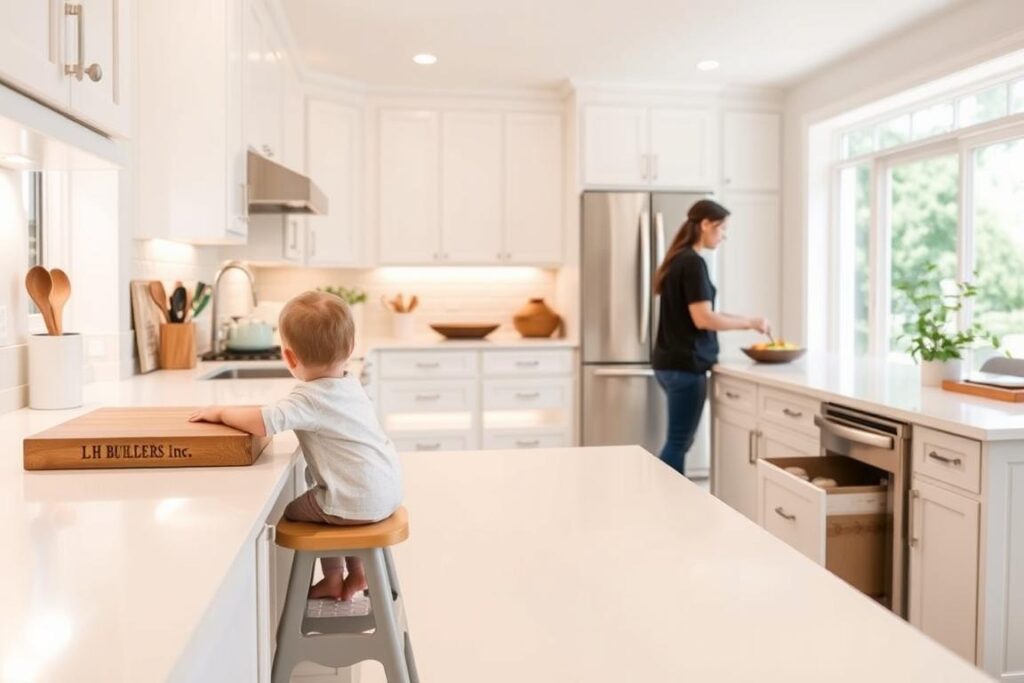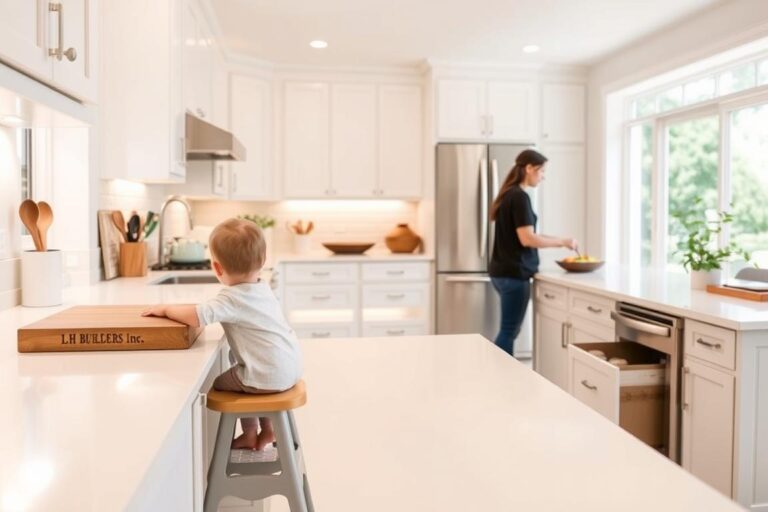We know how important a safe kitchen is for your family. It’s a place where everyone can be together and have fun. Kitchen safety is key to keeping your family healthy and safe.
Keeping an eye on kids in the kitchen can lower injury risks by 70%. Also, washing hands well can cut down food illness by 50%. Simple steps like using safety locks and keeping sharp things away can make your kitchen safer.
Key Takeaways
- Implementing child safe kitchen practices can reduce the risk of injury among children by approximately 70%.
- Proper handwashing can reduce the spread of foodborne illness by 50%.
- Using child safety locks and storing sharp instruments separately can prevent unintentional injuries in the kitchen.
- Enclosing high-risk kitchen areas with baby gates or safe spaces can reduce the likelihood of accidents.
- Installing cabinet locks can decrease access to toxic substances for small children.
- Regularly educating children about kitchen tools and safety practices can reduce misuse and accidents.
By following these tips and using childproof kitchen ideas, you can make your kitchen a safe place. It’s where your family can enjoy cooking and being together.
Importance of a Child Safe Kitchen
We know how vital it is to make a kitchen safe for kids. The USDA says kids under five are more at risk for food sickness. This is because their immune systems are still growing.
Kids have thinner skin than adults, making them more likely to get hurt from burns. The 3-5 Rule helps keep kids safe by keeping them away from hot things like stoves and ovens. By teaching safe cooking and safety in the kitchen, we can lower the risk of accidents. This makes a safe place for kids to learn and grow.
- Supervising children while cooking to prevent accidents
- Teaching children about kitchen safety and food preparation
- Using safe cooking practices, such as cooling hot liquids before consumption
By following these tips and focusing on safety, we can make a safe and caring space for our kids to grow.
Evaluating Your Kitchen Space
We know how important it is to keep our kids safe, and the kitchen is key. To make it safe, we need to check the space and find risks. This means looking at the layout, the appliances, and where dangerous stuff is stored.
The HHS says kids under five are more at risk for food sickness. Their immune systems are still growing. So, we must prevent accidents and keep the kitchen safe.
Some dangers in the kitchen include:
- Cleaning supplies and toxic materials
- Stove burner knobs
- Dishes and glassware
- Small appliances
We can make the kitchen safer by installing locks on doors and cabinets. Using garbage can covers with locks helps too. Securing big appliances also makes a big difference. These steps help a lot in keeping our kids safe.
Child-Proofing Basics
Creating a child safe kitchen is key. The American Academy of Pediatrics says we must check our home’s safety often. This is to keep up with our child’s growth.
We can start by putting locks on cabinets and using covers for stove knobs. This helps prevent accidents.
Some important steps include:
- Securing heavy appliances to prevent tip-overs
- Using multi-use latches to prevent cabinet and drawer accidents
- Storing hazardous materials out of reach
By taking these steps, we make our kitchen safer for kids. A safe kitchen is not just about safety devices. It’s also about watching our kids and teaching them.
As we keep making our kitchen safer, we should learn about new safety products. This way, our kitchen stays a safe place for our kids to grow.
| Childproofing Measure | Benefits |
|---|---|
| Installing cabinet locks | Prevents access to hazardous materials |
| Using stove knob covers | Prevents accidental stove activation |
| Securing heavy appliances | Prevents tip-overs and accidents |
Safe Cooking Practices
We think it’s key to cook safely with kids in the kitchen. It keeps our kitchen safe and healthy. The USDA says teaching kids about kitchen safety is very important.
Some important facts about cooking safely with kids are:
- 10,000 kids get burned each year from instant soups and noodles.
- Young kids (under 4) often get scald burns from hot liquids.
- Older kids (5 to 15) get more fire burns.
Teaching kids how to cook safely can lower kitchen accident risks by 30%. Using dull knives for young kids can cut down on cuts by 50%. It’s good to start kids in the kitchen early to help them eat well.

By following these tips, we can make our kitchens safe for our kids to grow and learn.
| Age Group | Type of Burn | Prevention Measures |
|---|---|---|
| 4 and under | Scald burns from hot liquids | Supervise closely, use cool water for cooking |
| 5-15 | Fire and flame burns | Teach fire safety, keep a fire extinguisher nearby |
Proper Storage Solutions
Creating a kid-friendly kitchen needs good storage solutions. The USDA and others say it’s key to keep harmful stuff and tools safe. Use kid-friendly kitchen tips like cabinet locks and stove knob covers to avoid accidents.
Some good storage ideas include:
- Organizing utensils and tools in a special area, like a drawer or pegboard
- Putting harmful stuff, like cleaning supplies and sharp things, in a locked cabinet or high shelf
- Using clear containers and labels to help kids find what they need
These childproof kitchen ideas help make your kitchen safer. For instance, using locks on lower cabinets can cut accident risks by 60%. Also, making kitchen edges round can lower injury risks by 40%.
A tidy kitchen is safer and works better. By using these tips, you make your kitchen safe and useful for your family.
| Storage Solution | Benefits |
|---|---|
| Utensil drawer | Keeps utensils organized and within reach |
| Locked cabinet | Stores hazardous materials safely and securely |
| Clear containers and labeling system | Helps children find what they need and reduces clutter |
Safety Equipment You Should Have
Creating a child safe kitchen is key. The HHS says having fire extinguishers, first aid kits, and smoke alarms is vital. These items help keep your kitchen safe, which is crucial for kids.
A child safe kitchen means more than just locking cabinets. It’s also about being ready for emergencies. Here are some safety items you should have:
Fire Extinguishers
Fire extinguishers are a must in every kitchen. They help stop small fires from getting bigger. Pick one that works for grease or electrical fires.
First Aid Kits
A first aid kit is key for minor injuries like cuts and burns. Make sure it has bandages, antiseptic wipes, and pain relievers.
Smoke Alarms and Carbon Monoxide Detectors
Smoke alarms and carbon monoxide detectors are vital. They help spot dangers early. Make sure they’re working right.
With these items, you can make your kitchen safe for kids. Always check your safety gear to make sure it works.
Good kitchen safety habits are also important. Wash your hands often and keep raw meats away from food that’s ready to eat. With the right gear and habits, you can avoid accidents and keep your kitchen safe.
Educating Children About Kitchen Safety
Teaching kids about kitchen safety is key to a safe kitchen. The USDA says it helps avoid accidents and builds a safe culture.
The National Fire Protection Association says cooking gear causes 49% of home fires. This shows why child safety in the kitchen and kid-friendly kitchen tips are vital.
To teach kids about kitchen safety, we suggest:
- Give lessons on kitchen safety and manners that fit their age.
- Make safety checklists so kids know what to do and not to do in the kitchen.
- Practice different scenarios to get kids ready for emergencies.
By doing these things, we can make a safe place for our kids to grow. Remember, child safety in the kitchen is a team effort. Together, we can stop accidents and build a safe culture.
Instilling Kitchen Manners
Creating a child safe kitchen means teaching our kids good kitchen manners. This includes keeping things clean and organized, respecting cooking space, and knowing about food safety. These habits help make our kitchen a safe and respectful place.
The USDA says teaching kids about kitchen safety and manners is key. We should teach them to wash their hands before cooking and how to use utensils and appliances safely.
Here are some important kitchen manners to teach our kids:
- Respecting cooking boundaries, such as not touching hot surfaces or sharp objects
- Understanding food safety, such as not eating raw or undercooked food
- Practicing cleanliness and order, such as cleaning up after meals and putting away utensils and appliances
Teaching these manners helps make our kitchen safe and healthy for kids. It also builds a culture of respect and teamwork in our kitchen. Everyone helps prepare and enjoy meals together.
Maintaining a Child Safe Kitchen
Keeping a kitchen safe for kids is a big job. We need to watch out all the time and keep getting better. By doing safety checks often, we can find and fix dangers. This way, our kitchens stay safe as our kids get older and their needs change.
It’s important for the whole family to help keep the kitchen safe. Teaching kids how to handle food and stay away from dangers is key. Also, we should all review and update safety together. This makes sure everyone works together to keep the kitchen safe.
A safe kitchen helps our kids learn to cook and love making healthy meals. By focusing on safety, we protect our kids and help them enjoy cooking. They can be creative and confident in the kitchen.
FAQ
What are the key aspects of creating a child-safe kitchen?
How can I assess the safety of my current kitchen setup?
What are some effective childproofing techniques for the kitchen?
How can I promote safe cooking practices in my kitchen?
What safety equipment should I have in my kitchen?
How can I educate my children about kitchen safety?
What kitchen manners should I teach my children?
How can I maintain a child-safe kitchen over time?
Source Links
- https://www.pennilessparenting.com/2024/05/kitchen-safety-101-essential-rules.html
- https://www.healthychildren.org/English/safety-prevention/at-home/Pages/Kitchen-Safety.aspx
- https://www.childrensdayton.org/the-hub/childproofing-your-kitchen-complete-safety-guide
- https://www.valleychildrens.org/blog/keeping-kids-safe-in-the-kitchen
- https://www.connecticutchildrens.org/growing-healthy/6-reasons-why-its-important-cook-your-kids
- https://kidshealth.org/en/kids/safe-in-kitchen.html
- https://staysafe.org/home-safety/childproofing-your-home-for-kids/
- https://www.kitchencabinetdepot.com/blog/baby-proofing-cabinets.html?srsltid=AfmBOopnyw5GfXFDqUuIfa0ePiC1ohvHu2vPppG1uVmA5I6yzluweuA4
- https://www.dreft.com/en-us/parenting-tips/after-baby-arrives/baby-proofing-and-baby-safety
- https://www.parents.com/baby/safety/babyproofing/babyproofing-your-home-from-top-to-bottom/
- https://www.mostlyorganicmother.com/blog/baby-proofing-your-home-heres-what-we-like
- https://www.whattoexpect.com/nursery-decorating/childproofing-basics.aspx
- https://www.childrenscolorado.org/just-ask-childrens/articles/kitchen-safety-tips/
- https://www.primafoodie.com/home/kidsandcookingsafetyessentials
- https://www.alicecabinetry.com/blog/designing-a-kid-friendly-kitchen
- https://kitchencabinetkings.com/childproof-kitchen?srsltid=AfmBOorfisrMyKV-zcWUvoSJONnGkqMnaA6G4cSaGK53FPFAPrfxBRSX
- https://oishya.com/journal/child-friendly-knives-in-the-kitchen-safety-tips/
- https://alarmrelay.com/childproof-kitchen/
- https://www.thespruceeats.com/teach-kids-food-and-kitchen-safety-481268
- https://thesuperteacher.com/2017/02/kitchen-safety-activity/
- https://eatwheat.org/learn/cooking-kids-kitchen/
- https://mcpress.mayoclinic.org/parenting/safety-in-the-kitchen-during-feedings-near-bodies-of-water-and-around-burn-hazards/
- https://www.ikea.com/us/en/safety-at-home/child/kitchen/
- https://www.rasmussencc.com/baby-and-child-proof-your-kitchen/




